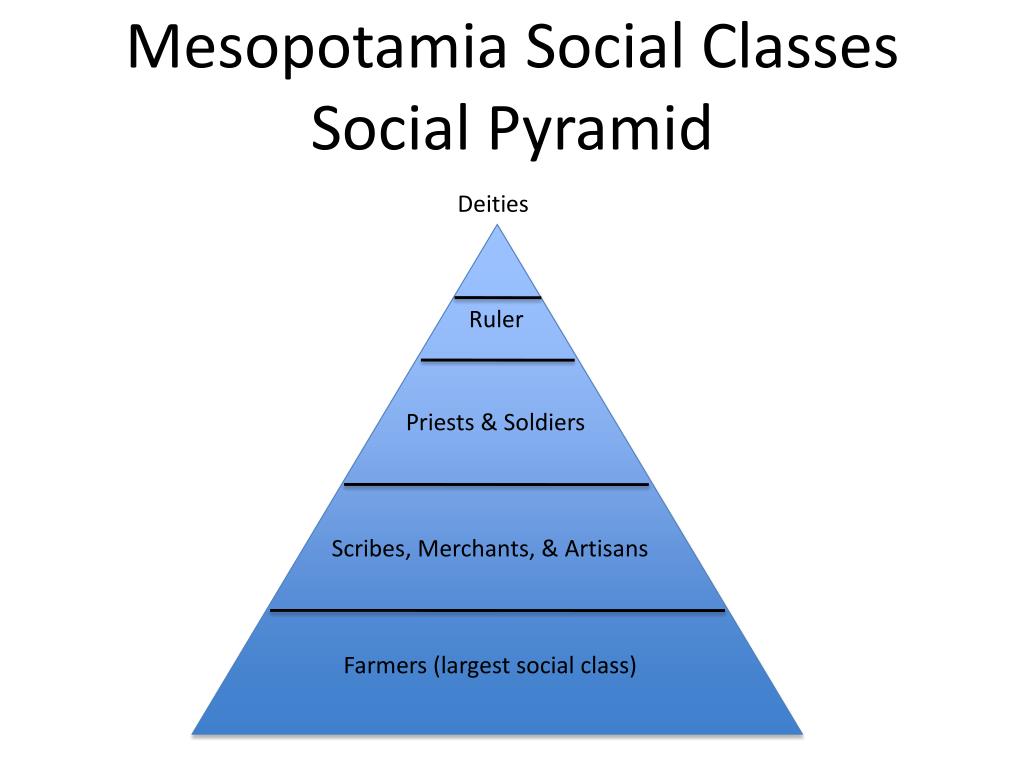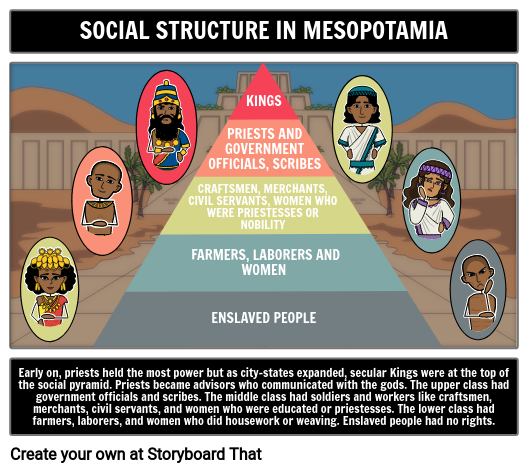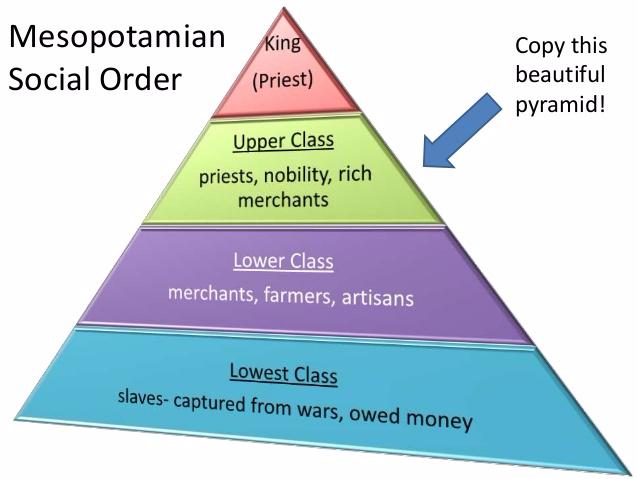Understanding Social Classes In Ancient Mesopotamia: Who Was Who?
Have you ever wondered what life was like for people living thousands of years ago? It's almost fascinating to think about how ancient societies organized themselves, especially in places like Mesopotamia, where some of the very first cities came into being. You see, understanding the way people lived back then, and who had what role, really helps us grasp the foundations of human civilization. It's a bit like looking at the building blocks of how we live now, so to speak.
This ancient land, often called the "Cradle of Civilization," was a very, very busy place. People were inventing writing, building grand temples, and figuring out complex irrigation systems. But within all that innovation, there was a clear structure to society. It wasn't just everyone doing their own thing; there were distinct groups of people, each with their own place and duties, you know.
So, what did this social order look like? We're going to explore the different social classes in Mesopotamia, from the powerful rulers and priests right down to the people who worked the land and those who had very little freedom. We'll look at how these groups interacted, what their daily lives might have been like, and why this system was so important to how their world worked, at the end of the day.
- Vintage Family Nudist
- Moosa Mostafa Ethnicity
- Link Somali Telegram 2025
- V3 Vegamovies.bitbucket.io
- Jay Harrington Girlfriend
Table of Contents
- Understanding Mesopotamia's Social Fabric
- The King and the Priests: At the Top
- The Noble Class and High Officials
- The Common People: Farmers, Artisans, and Soldiers
- Slaves: The Lowest Rung
- Laws and Social Mobility
- Connecting Ancient Records to Modern Systems
- Why Understanding Mesopotamia's Classes Still Matters Today
- Frequently Asked Questions About Mesopotamian Social Classes
Understanding Mesopotamia's Social Fabric
Mesopotamia, located between the Tigris and Euphrates rivers, was a place of incredible innovation. It was here that people first began to live in large settlements, forming cities that grew quite big. This change from small farming villages to bustling urban centers meant that new ways of organizing people became very necessary, naturally.
Early Beginnings and Urban Growth
As more people gathered in one spot, they needed systems for managing resources, distributing food, and maintaining order. You know, it wasn't just about farming anymore. There were specialized workers, like potters and weavers, and they all needed a place within the growing community. This growth really pushed the development of a structured society, as a matter of fact.
The rise of large temples and palaces also played a big part. These grand structures weren't just buildings; they were centers of power and economic activity. They employed many people and managed vast amounts of wealth. This, in turn, helped create different levels of importance among the people, you see.
Why Social Order Mattered
A clear social order was pretty important for the stability of these early cities. It helped ensure that everyone knew their place and what was expected of them. This kind of structure made it easier to organize big projects, like building ziggurats or digging irrigation canals, which required many hands working together, of course.
Without some sort of hierarchy, it would have been much harder to manage complex societies. Think about it: who would decide where the water went, or who got what share of the harvest? A structured system provided answers to these questions, giving the society a way to function smoothly, more or less.
The King and the Priests: At the Top
At the very peak of Mesopotamian society were the kings and the high priests. These individuals held immense power, both political and religious. Their authority was often seen as coming directly from the gods, which gave their rule a very special kind of weight, naturally.
The Divine Connection
In Mesopotamia, religion was deeply woven into every aspect of life. The gods were believed to control everything, from the floods of the rivers to the success of the crops. So, it made sense that the people who communicated with these gods, the priests, held a very high position. They were, in a way, the intermediaries between the human world and the divine, you know.
Kings, too, often claimed a divine mandate. They were seen as chosen by the gods to rule and protect their people. This connection to the divine gave them incredible legitimacy and helped keep their power secure. It was, in fact, a very clever way to solidify their rule.
Royal Power and Influence
The king was the ultimate decision-maker, leading armies, overseeing justice, and managing the economy. He was responsible for the well-being of his city-state, or later, his empire. This meant he had a lot of people working under him, carrying out his commands and managing the day-to-day operations, so to speak.
High priests, on the other hand, managed the vast temple estates, which were often very wealthy and owned a lot of land. They oversaw rituals, collected offerings, and provided spiritual guidance. Their influence was significant, and they often worked closely with the king, sometimes even challenging his authority, you see.
The Noble Class and High Officials
Just below the king and the high priests were the noble class and high-ranking officials. These were people who held important positions in the government, the military, or the temple administration. They were, you know, the backbone of the state's operations.
Landowners and Administrators
This group included wealthy landowners, successful merchants, and scribes who managed records for the state or temples. They often had significant personal wealth and influence. They were the ones who helped make the system run, basically.
Administrators, in particular, played a very important role. They were responsible for collecting taxes, managing resources, and overseeing public works projects. Their work was essential for keeping the city organized and functioning. It was, arguably, a lot of detailed work.
Their Role in Society
Members of this class enjoyed many privileges. They lived in larger homes, had access to better food and resources, and often received a good education, especially the scribes. They were, in a way, the managers of society, carrying out the will of the king and priests, and helping to maintain order, you know.
Their influence extended into various aspects of daily life, from legal matters to economic transactions. They were the ones who ensured that the laws were followed and that the economy kept moving. This group was, in fact, crucial for the overall stability of the Mesopotamian states.
The Common People: Farmers, Artisans, and Soldiers
The vast majority of the Mesopotamian population belonged to the common people. This broad group included farmers, artisans, craftsmen, and soldiers. They were the ones who produced the food, made the goods, and protected the city, more or less.
Life in the Fields and Workshops
Farmers were, without a doubt, the most numerous group. They worked the land, growing barley, wheat, and other crops that fed the entire population. Their lives were tied to the cycles of the seasons and the rivers, and their hard work was essential for survival. It was, you know, a very demanding life.
Artisans and craftsmen, on the other hand, specialized in making things. This included potters, weavers, metalworkers, carpenters, and jewelers. They often lived in specific quarters of the city and their skills were highly valued. They made everything from everyday tools to beautiful ornaments for the wealthy, you see.
The Military's Place
Soldiers were also part of the common class, though their role was unique. They protected the city from invaders, expanded the king's territory, and maintained order. Their lives could be very difficult and dangerous, but they were essential for the security of the state. They were, basically, the protectors of the realm.
While they didn't have the wealth or power of the upper classes, common people had certain rights and protections under the law. They could own property, engage in trade, and participate in some legal proceedings. Their lives were, of course, generally simpler, focusing on family, work, and community.
Slaves: The Lowest Rung
At the very bottom of the social hierarchy were slaves. Their status was significantly different from that of free people, and they had very few rights. Their lives were often difficult, and they were considered property, basically.
How One Became a Slave
People could become slaves for various reasons. One common way was through capture in warfare. When one city conquered another, the defeated population might be enslaved. Another reason was debt; if a free person couldn't pay their debts, they might be forced into servitude. Children born to slave parents were also slaves, you know.
Sometimes, people might even sell themselves or their children into temporary slavery during times of extreme hardship, just to survive. This was, in a way, a desperate measure to avoid starvation. It shows how truly tough life could be for some, you see.
Their Daily Lives
Slaves performed a wide range of tasks. Some worked in the fields, others in workshops, and many served in wealthy households. They could be domestic servants, agricultural laborers, or even skilled artisans. Their daily lives were entirely dependent on their owners, naturally.
While their lives were harsh, Mesopotamian law did offer some protections for slaves. They could, for example, sometimes buy their freedom, or be freed by their owners. They could also marry free people, and their children might even gain a different status. It wasn't a completely hopeless situation for every single slave, in some respects.
Laws and Social Mobility
Mesopotamian society was governed by laws that reinforced the existing social structure. The famous Code of Hammurabi, for instance, clearly shows how different classes were treated under the law. It's a very clear example of how their rules worked, you know.
Hammurabi's Code and Class Distinctions
Hammurabi's Code, which dates back to around 1754 BC, laid out specific punishments and compensations based on the social status of the people involved. For example, if a free person injured another free person, the punishment might be different than if a free person injured a slave. This really highlights the class distinctions that were baked into their legal system, you see.
The laws were designed to maintain order and protect the interests of the various classes, though obviously favoring the upper echelons. They show us, quite clearly, what was considered important and how justice was administered in that ancient world.
Glimmers of Change?
While the social hierarchy was generally rigid, there was some limited social mobility. A skilled artisan might gain enough wealth to improve their standing, or a soldier could earn recognition and promotion through bravery. It wasn't common, but it wasn't impossible, either.
Also, scribes, though often from the common class, could rise to positions of considerable influence due to their literacy and administrative skills. Their ability to read and write was a very valuable asset, and it could open doors for them, as a matter of fact.
Connecting Ancient Records to Modern Systems
When we think about how societies work, even today, there's a lot of organization behind the scenes. You know, like how our modern systems, perhaps like the Social Security Administration, keep track of important details for people, allowing them to apply for benefits or check on their records. Well, a very long time ago, in Mesopotamia, they also had incredibly detailed ways of managing their people and their roles. They didn't have online services to save a trip to an office, of course, but their scribes and administrators were, in a way, keeping tabs on who was doing what and what their place was in the bigger picture. It's a bit like an early, very different form of societal record-keeping, you see.
The Importance of Record-Keeping
Mesopotamians were pioneers in record-keeping. They developed cuneiform writing, which allowed them to document everything from grain harvests and trade agreements to legal judgments and temple inventories. These records were crucial for managing their complex society and its various social classes. They didn't have a national 800 number to call, but they had very organized archives, apparently.
These ancient documents, often on clay tablets, helped administrators keep track of who owed what, who owned what, and who was assigned to which task. It was, in essence, their way of having an official record, much like how modern organizations rely on precise data to function. You can learn more about how ancient administrations managed their affairs on our site, for instance.
Echoes of Administration
While the methods were vastly different, the underlying need for administrative systems to manage a population's contributions and entitlements was present even then. They didn't have compassionate allowances to accelerate processes, but they had systems for managing resources and labor. This continuous need for organized management, in some respects, connects ancient practices to our own, even if it's a very loose connection.
Just as we might use online services to apply for benefits or check a claim status today, Mesopotamian officials had their own established procedures for managing the flow of goods and services, and for understanding the roles of different people within their system. It shows, basically, that the idea of keeping track of people and their societal contributions is a very old one, you know.
Why Understanding Mesopotamia's Classes Still Matters Today
Studying the social classes of Mesopotamia offers us a fascinating look into the early development of human society. It helps us see how people organized themselves when cities first began to form. We can learn a lot about power, authority, and the daily lives of people from a very different time, you know.
These ancient structures, while long gone, provide valuable insights into how social hierarchies can emerge and function. They show us the roots of many societal patterns that, in some form, have continued through history. It's a bit like looking at the blueprints of early human communities, you see. For more detailed historical context, you might want to visit the British Museum's Mesopotamia collection.
Frequently Asked Questions About Mesopotamian Social Classes
People often have questions about how ancient societies were structured. Here are some common ones about Mesopotamia:
What were the main social classes in Mesopotamia?
The main social classes in Mesopotamia typically included the king and high priests at the very top, followed by the noble class and high officials. Below them were the common people, which included farmers, artisans, and soldiers. At the bottom were slaves. This was, in essence, the general setup, you know.
Could people change their social class in Mesopotamia?
While the social hierarchy was generally quite fixed, there was some limited social mobility. For example, a skilled artisan might gain enough wealth to improve their standing. Also, slaves could sometimes buy their freedom, or be freed by their owners, which was, you know, a big change for them.
How did laws affect social classes in Mesopotamia?
Laws in Mesopotamia, like Hammurabi's Code, clearly showed different treatments based on social status. Punishments or compensations for offenses often varied depending on whether the people involved were free citizens, commoners, or slaves. This truly reinforced the existing class distinctions, so to speak. You can learn more about ancient legal systems here.
- Fik Fap Indian
- Link Somali Telegram 2025
- Mario Kart 8 Deluxe Rom
- Trevor Wallace Girlfriend
- Jameliz Benitez Smith Leak

Mastering The Social Pyramid Of Mesopotamia: Unveiling Ancient Hierarchies

Mesopotamia Social Structure: Lesson Plan by Storyboard That

These classes were: